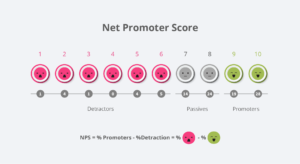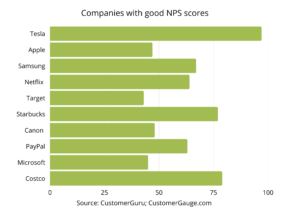If a tree is known by its fruit, a business is known by its Net Promoter Score (NPS). This special number clearly demonstrates how well a product or service fits its target audience and market demands. It also shows competitiveness and helps with business strategy development.
At MightyCall, we’re active users and promoters of NPS. A consistently above-average and growing NPS score helps us develop an award-winning SaaS product, expand in-demand product features, and increase ROI.
Here’s all you need to know to make NPS part of your business strategy – in fact, you’ll be surprised at how simple but powerful this metric is. All you need is the answer to one question!
Navigate:
- What is NPS?
- Transactional and relational NPS programs: What to use?
- Why is NPS important?
- How to calculate your Net Promoter Score?
- NPS survey questions
- How to collect NPS feedback
- How to read NPS survey results
- How to interpret Net Promoter Score
- How we put NPS data to use at MightyCall
What is Net Promoter Score (NPS)?
Net Promoter Score (or NPS) is a potent metric showing customer satisfaction and customer loyalty in one simple number. Business strategist Fred Reichheld first described the concept of NPS in 2003 and coined the term “Net Promoter Score”.
Reichheld’s discovery of the NPS metric was based on the observation of successful companies and added to years of customer research. Reichheld found that the essence of customer relationships – both happy and poor ones – boils down to how consumers answer one question: how likely they are to recommend a product or service to someone else.
Once Reichheld realized this, he figured that, instead of posing this question in the (usually ignored) customer experience survey, it can be isolated into an exclusive metric. To calculate this metric, you don’t need any complicated formulas.
Transactional and Relational NPS programs: What to use?
Businesses have two ways of evaluating their Net Promoter Score, called “Transactional NPS” and “Relational NPS”. The two can be used interchangeably or individually.
A Transactional NPS survey measures customer satisfaction after a certain transaction or special interaction with a customer takes place. It works best for medium to large businesses that have many transactions going on and need to evaluate their weak/strong points based on those transactions.
Send Transactional NPS surveys:
- After registration
- After a new order
- Following communication with a customer (customer tickets, calls, messages, etc.)
- After product/service installation or download
- After making changes to the product or service (upgrades/updates/subscription changes, etc.)
A Relational NPS survey measures standard, day-to-day interaction with a customer. It shows your relationship on a daily basis. No matter how big or small your business is, you’ll benefit from regular data gathered by such surveys.
Send Relational NPS surveys:
- To define customer satisfaction on a regular basis
- To evaluate company performance without reference to a specific product/service
- At set intervals of time. Quarterly or twice a year is an optimal choice.
Why is NPS important?
When Reichheld revealed NPS to the world in Harvard Business Review, he titled that article “The one number you need to grow”. In fact, NPS is quite an amazing metric because it focuses on the number of clients who aren’t just “users” of a product or service, but its active promoters (read: cheerleaders).
Knowing the NPS score of a product or service will help:
- Evaluate customer experience
- Demonstrate customer loyalty
- Show market competitiveness
- Provide important data for sales, marketing, and product development
- Help adapt the business/product strategy
NPS is a highly effective tool for companies with various subscription plans, product/service lines, buying options, etc. This simple but powerful metric clearly demonstrates which product line, subscription plan, etc. secures the most loyal customers, is most competitive and has the most potential for growth.
For example, at MightyCall, we segment our NPS survey based on different subscription plans and user categories. However, we exclude those clients who’re just completing their trial. Remember that you want to understand your most enthusiastic audience, so if you have a free trial plan, those users shouldn’t be included in the NPS survey.
How to calculate your Net Promoter Score?
NPS scores are based on a one-question survey that customers answer using a rating of 0-10. To calculate NPS, you take the percentage of customers who gave you a grade of 6 or lower (“Detractors”) and subtract it from the percentage of customers who gave you a 9-10 (“Promoters”). Those who replied with a 7-8 rating (“Passives”) aren’t counted.

For example, let’s say 40% of your customers are “Promoters”, 45% “Passives” and 15% “Detractors”. You’ll need to subtract: 40-15 = 25. This means your NPS score is 25.
NPS scale
The Net Promoter Scale is a unique metric that segments customers into 3 groups: Promoters, Detractors, and Passives.
Promoters – Promoters are your happiest customers. They’re the ones who replied to your NPS survey question with a solid 9 or 10.
Passives – This group neither likes nor hates your product or can’t make up their mind. They are the ones who give a 7-8 rating on the NPS survey.
Detractors – Detractors are your least satisfied customers, the ones who have problems with the product or service. They replied to the survey questions with a 0-6 rating.
?Important: Although NPS takes all three customer groups into account, the NPS score itself is calculated only from the grades given by Promoters vs. Detractors. The particular thing about an NPS score is that it bypasses the percentage of lukewarm (or “Passive”) customers altogether.
NPS survey questions
NPS surveys are generally based on one simple question:
“Based on a scale of 0-10, how likely are you to recommend us to your friends or colleagues?”

Sample Relational NPS survey questions:
- “Based on a scale of 0-10, how likely are you to recommend our company to someone you know?”
- “Based on a scale of 0-10, how likely are you to recommend our product to your friends or colleagues?”
- “Based on a scale of 0-10, how likely are you to recommend our service to your friends or colleagues?”
Sample Transactional NPS survey questions:
- “Thanks for registering with us! Based on your registration experience, how likely are you to recommend us to your friends or colleagues?”
- “Thanks for the purchase! Based on your buying experience, how likely are you to recommend us to your friends or colleagues?”
- “Glad to help you! Based on your experience of contacting our support team, how likely are you to recommend us to your friends or colleagues?”
- “Thanks for installing [product X]! How likely are you to recommend it to your friends or colleagues based on this experience?
- “Welcome to our updated product version! Based on your experience, how likely are you to recommend us to your friends or colleagues?”
How to collect NPS feedback
When you’ve decided on the kind of NPS survey(s) you’ll be gathering, there are several ways to collect feedback from your customers. Below, we’ll take a look at the most popular
Website survey
A website NPS survey is a customer feedback form that pops up on your website or in-product. It can also be a pop-up in the mobile version of your product or service (or a mobile app, if you have one).
A Transactional NPS surveys. For example, set this pop-up survey after registration, a purchase, a download, a product upgrade, etc.
Email survey
If setting up a pop-up takes too much time or you aren’t that tech-savvy, send a simple NPS survey by email. This survey must include the questions with the scale for rating customer experience and may include a follow-up question where the customer can in their own words express their experience of the product or service.
E-mail surveys several days to weeks after gaining a new customer or sealing a deal. Suitable for both Transactional NPS surveys and Relational NPS surveys.
Phone survey
For businesses that don’t have large online audiences, including local businesses and services, it’s optimal to carry out a phone survey. Be prepared for dropped calls, but the upside here is that you can get a lot more feedback from live interaction compared to a pop-up or email survey.
Businesses that mostly communicate with customers via the phone. Phone surveys work best for Relational NPS surveys.
? Important: Regardless of the chosen method of collecting feedback, it’s highly useful to include a direct follow-up question to gain insight into why your customers view your product in such a way. If using a pop-up survey or email survey, you can set an automatic follow-up question based on the given score. If doing phone surveys, instruct your customer service agents to ask this question.
Sample follow-up question for Promoters: “We’re grateful for your feedback! If there’s anything you specifically enjoyed about our product, please share below!”
Sample follow-up question for Passives: “Thank you for the response. Please let us know how we can improve our service to serve you better.”
Sample follow-up question for Detractors: “We’re sorry your experience with us didn’t go well. Please take a moment to share your problem so we can improve our service.”
How to read NPS survey results
Now that you’ve received your NPS surveys back, let’s see what we can do with the results. Although NPS is based on a genuinely simple concept, it can also provide in-depth knowledge about where your company is going. The amazing thing about NPS surveys is that you can make them as simple or advanced as you want.
- Segment your data – If you’re just starting out with NPS, knowing your company’s general NPS score is a great starting point. However, if you’re an experienced user, we suggest segmenting NPS data by criteria such as gender, age, location, new customer/returning customer, the type of subscription or service bought/provided, etc.
- Keep tracking results – The more data you have, the more ROI you’ll get out of it. Establish set intervals for sending out NPS surveys, such as quarterly. After just 18 months, you’ll have 6 different data sets to compare, contrast, and segment.
- Present the information companywide – NPS data shouldn’t stay locked up in your Business Analyst’s desk. Share it with the Product, Marketing, Sales, Customer Service, and other departments that have relation to your product/service and customers.
How to interpret Net Promoter Score
You know the saying, “One man’s love boat is another’s Titanic”? The same holds true for NPS scores. One and the same number could mean a great achievement for one industry and a total fiasco for another. Let’s take a closer look at how to interpret NPS scores.
What is a good NPS score?
A good NPS score is one that’s aligned with the average metrics for its industry. The numbers widely vary and range from 30 in telecommunications to nearly 60 in healthcare. Generally speaking, an NPS over 0 shows that you have more happy customers than grumpy ones, which is good news. However, a score of 0 may only be acceptable for very new businesses that are just figuring out their customer strategy.

What is a bad NPS score?
Since NPS scores vary widely by industry, a bad NPS score is one that falls out of the acceptable industry range. However, regardless of industry, if your score is -X, that’s a big red flag. A negative score signifies that a company has more Detractors than Promoters and that a product or service is losing customers.

Median NPS scores by industry
As we mentioned above, you should always check your Net Promoter Score against the average for your specific industry. Here’s a list of the most popular industries and their median NPS scores.

How we put NPS data to use at MightyCall
The IT and telecommunications sector is notorious for some of the lowest NPS scores in the industry. For example, AT&T has an NPS score of 15 while the NPS of Verizon descends all the way down to 7. The reasons behind such poor ratings are usually connectivity issues, billing problems, hidden fees/charges, and poor customer service.
At MightyCall, we started measuring NPS in 2019 and immediately made it a priority to focus on the aspects that give the most pain to telecom clients: connectivity, customer service, and product usability. The NPS survey feedback we gathered and analyzed has been an immense shortcut in growing both customer satisfaction and ROI.
What we do with NPS data at MightyCall:
- Segment NPS data based on user plans – this allows us to see which plans have the most loyal customers, are more competitive, etc. based on the NPS score
- Segment the data based on user roles in our product – this gives a glimpse into the user satisfaction based on their product usage (e.g. admins vs. regular users)
- Follow up with direct feedback (comments) – for an in-depth overview
It’s important to note that getting detailed feedback from both Promoters and Detractors is highly valuable for a company, especially in the ultra-competitive SaaS industry.
Getting detailed feedback from Promoters helps:
- Understand the strong points of the product
- See positive trends from gathering comments several years in a row
- Understand the language of our loyal customers – the words they use most often to describe what they love about the product
Getting detailed feedback from Detractors helps:
- Understand the challenges needed to solve in order to gain more loyal customers
- Identify negative aspects before they have a chance to become trends
- See what language customers use to describe their pain points since language is often the most emotionally telling way of communicating a problem
Remember how Reichheld titled his article “The one number you need to grow” (not just “know”)? To understand if your NPS score is growing, by what percentage, and in what directions, you should be analyzing those numbers back to back over a few years. For MightyCall, consecutive NPS analysis added to other customer research has been a major factor in forming a prioritized product roadmap.
Coincidentally, since starting to analyze our NPS in 2019, we’ve received some very special awards, like making the Inc.5000 list as one of the “fastest-growing private companies in the U.S.”. Moreover, reviewers constantly mention our “excellent customer service”. So today, whenever we talk about NPS, we gather the whole team for the meeting. Colleagues from departments like Programming, BA, Marketing, and Sales all have a lot to learn from NPS data and a lot to brainstorm later.
NPS is the fastest way to grow your business
At MightyCall, our team discovered that our growing, consistently above-average NPS score is a lot more than a number. Growing our NPS score directly correlates to growing our product and vice-versa. And every day, that reflects in increased customer loyalty, high-quality reviews, and top industry awards.
To make NPS work for you just like it does for us, keep these tips in mind:
- An NPS score is calculated from a single-question survey sent out to customers, excluding trial customers
- A good NPS score varies widely by industry but is generally 30 and above
- Segment NPS results based on your product/service categories, plans, and users
- Supplement NPS scores with feedback from both Promoters and Detractors
- Present NPS data and feedback to your extended team and brainstorm it together.





























